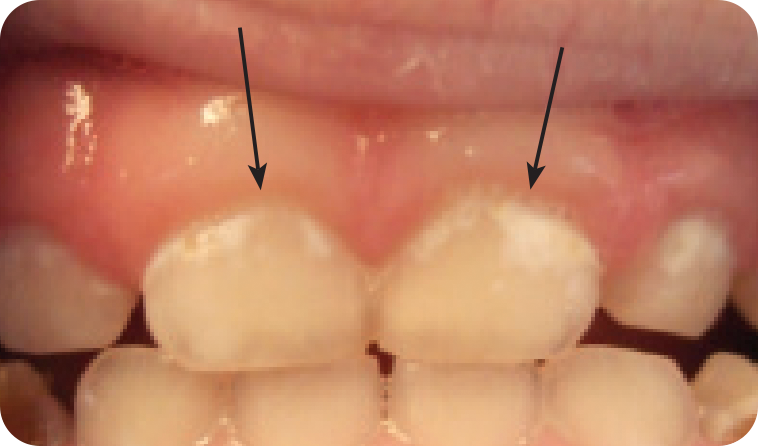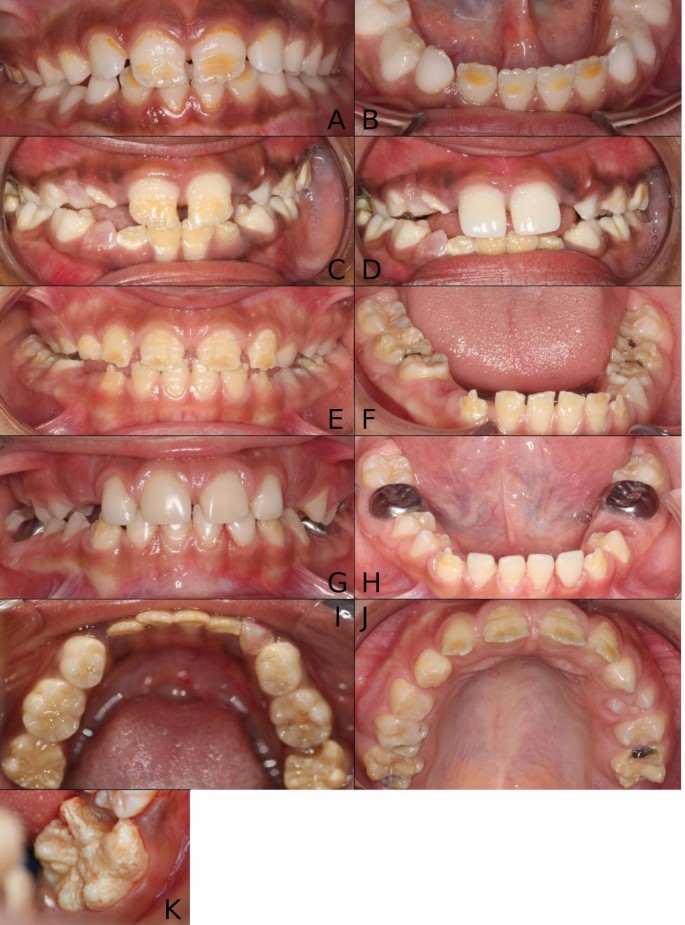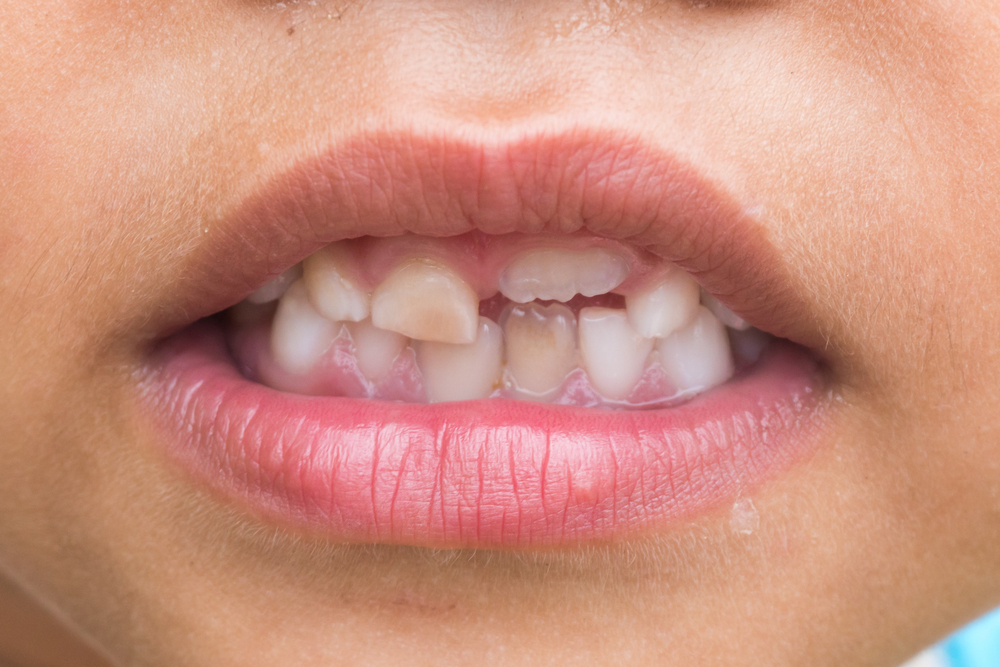Your Enamel hypoplasia baby teeth images are available in this site. Enamel hypoplasia baby teeth are a topic that is being searched for and liked by netizens today. You can Get the Enamel hypoplasia baby teeth files here. Get all free photos and vectors.
If you’re searching for enamel hypoplasia baby teeth images information linked to the enamel hypoplasia baby teeth interest, you have come to the ideal blog. Our site frequently provides you with suggestions for viewing the maximum quality video and picture content, please kindly search and locate more informative video content and images that match your interests.
Enamel Hypoplasia Baby Teeth. Inherited developmental conditions vitamin deficiencies maternal illness medications given to mother prior to birth or to the child during early childhood when teeth are developing preterm birth low birthweight trauma to the teeth infection malnutrition systemic diseases and. Enamel for permanent teeth occurs during the first three years of a childs life. Hypoplasia of tooth enamel a baby can receive and in case of prematurity as a result of trauma received during birth as well as with poor diet severe forms of diseases transferred to the infants. In severe cases the enamel does not develop at all.
 Enamel Hypoplasia Toddler Life Babycenter Australia From babycenter.com.au
Enamel Hypoplasia Toddler Life Babycenter Australia From babycenter.com.au
Most of the time it happens before the age of three when the enamel is still developing and more vulnerable to genetic or environmental factors. More than 75 of enamel defects in the primary teeth of children are considered to be developmental in nature. Disturbances to the matrix formation process during this time period can lead to enamel hypoplasia in baby teeth. When your baby teeth and adult teeth grow sometimes the enamel doesnt fully develop. Enamel hypoplasia is a defect of the enamel that only occurs while teeth are still developing. There are many different causes of enamel hypoplasia from genetics to environmental factors.
Hypoplasia appears as brown or yellow stains and.
Your child may have as little as one tooth that is hypoplastic or as many as a mouthful. Enamel hypoplasia occurs when a tooth has less enamel than normal. Enamel Hypoplasia is a condition that results in having less enamel than normal. Enamel hypoplasia can be seen in both permanent and baby teeth. Hypomineralization is a genetic predisposition for a decreased mineral content in the teeth. Enamel hypoplasia is characterized by the discolored appearance of teeth and can occur in baby teeth andor permanent teeth.
 Source: kidsdentalonline.com
Source: kidsdentalonline.com
It can cause tooth sensitivity and lead to dental caries. Enamel Defect Enamel Hypoplasia Enamel defect is a d evelopmental d ental d efect D3 which can be implicated as weak or chalky enamel with reduced thickness or enamel with poor quality. Either the formation mineralization or maturation. Enamel hypoplasia occurs when a tooth has less enamel than normal. Still it can affect both baby teeth and permanent teeth.
Source:
Either the formation mineralization or maturation. Enamel hypoplasia can be seen in both permanent and baby teeth. Disturbances to the matrix formation process during this time period can lead to enamel hypoplasia in baby teeth. There are many different causes of enamel hypoplasia from genetics to environmental factors. Most of the time it happens before the age of three when the enamel is still developing and more vulnerable to genetic or environmental factors.
 Source: heightspedoortho.com
Source: heightspedoortho.com
This can present itself as naturally thinner enamel layers in newly developed teeth or it can occur as quick disintegration of the tooth enamel after teeth erupt from the gum line. The condition varies in terms of severity you can have one small spot of enamel hypoplasia on a single tooth or can have severely deformed enamel that changes the expected appearance of a tooth. More than 75 of enamel defects in the primary teeth of children are considered to be developmental in nature. The teeth with hypomineralization are sensitive and can cause children pain when eating and these teeth typically start to deteriorate once they grow in. The primary canine teeth begin to mineralize 19 weeks after conception and finish their enamel maturation process when the baby is nine months old.
 Source: heightspedoortho.com
Source: heightspedoortho.com
The inconvenience and potential harm of this situation is what calls for the immediate attention to this problem. There are many different causes of enamel hypoplasia from genetics to environmental factors. Enamel hypoplasia is a condition of your tooth enamel. Enamel hypoplasia is characterized by the discolored appearance of teeth and can occur in baby teeth andor permanent teeth. The primary canine teeth begin to mineralize 19 weeks after conception and finish their enamel maturation process when the baby is nine months old.
 Source: styleitaliano.org
Source: styleitaliano.org
An early birth can interrupt enamel formation that occurs in the womb. Hypoplasia that affects baby teeth may stem from low birth weight or a birth thats premature by approximately three months. There are many different causes of enamel hypoplasia from genetics to environmental factors. Enamel for permanent teeth occurs during the first three years of a childs life. The teeth with hypomineralization are sensitive and can cause children pain when eating and these teeth typically start to deteriorate once they grow in.
 Source: wmsmile.com
Source: wmsmile.com
Most of the time it happens before the age of three when the enamel is still developing and more vulnerable to genetic or environmental factors. Here are some common aspects of Hereditary Enamel Hypoplasia Darkened or gray baby teeth. On the other hand enamel hypoplasia is a condition where teeth have pits grooves and missing enamel. Either the formation mineralization or maturation. It is important to note that there are varying degrees of hypoplasia.
 Source: catsupandmustard.com
Source: catsupandmustard.com
This can present itself as naturally thinner enamel layers in newly developed teeth or it can occur as quick disintegration of the tooth enamel after teeth erupt from the gum line. Enamel is missing at least one of the three main stages in enamel. Enamel hypoplasia is a defect of the enamel that only occurs while teeth are still developing. Enamel for permanent teeth occurs during the first three years of a childs life. The enamel pathology is found in both dairy and permanent teeth with the latter accounting for the highest percentage of diseases leading to an increased risk and further to get other diseases.
 Source: researchgate.net
Source: researchgate.net
It can also result in smaller teeth. It can appear as a small pit or dent in a tooth or discoloration with excess white yellow or brown. There are many different causes of enamel hypoplasia from genetics to environmental factors. In severe cases the enamel does not develop at all. On the other hand enamel hypoplasia is a condition where teeth have pits grooves and missing enamel.
 Source: babycenter.com.au
Source: babycenter.com.au
Enamel for permanent teeth occurs during the first three years of a childs life. On the other hand enamel hypoplasia is a condition where teeth have pits grooves and missing enamel. Your child may have as little as one tooth that is hypoplastic or as many as a mouthful. Enamel hypoplasia is a defect of the enamel that only occurs while teeth are still developing. The inconvenience and potential harm of this situation is what calls for the immediate attention to this problem.
 Source: sciencedirect.com
Source: sciencedirect.com
Formation of the enamel on a childs baby teeth begins in utero and continues into infancy. Hypoplasia of tooth enamel a baby can receive and in case of prematurity as a result of trauma received during birth as well as with poor diet severe forms of diseases transferred to the infants. Hypoplasia that affects baby teeth may stem from low birth weight or a birth thats premature by approximately three months. Can Enamel Hypoplasia Affect Both Baby Teeth and Permanent Teeth. The condition varies in terms of severity you can have one small spot of enamel hypoplasia on a single tooth or can have severely deformed enamel that changes the expected appearance of a tooth.
 Source: thedentalstudio.ae
Source: thedentalstudio.ae
Enamel hypoplasia is a defect of the enamel that only occurs while teeth are still developing. Enamel for permanent teeth occurs during the first three years of a childs life. Enamel hypoplasia is characterized by the discolored appearance of teeth and can occur in baby teeth andor permanent teeth. It is important to note that there are varying degrees of hypoplasia. Enamel hypoplasia EH is a tooth enamel defect that results in a tooth or teeth having less than the normal amount of enamel.
 Source: nature.com
Source: nature.com
Formation of the enamel on a childs baby teeth begins in utero and continues into infancy. Enamel hypoplasia EH is a tooth enamel defect that results in a tooth or teeth having less than the normal amount of enamel. Enamel hypoplasia is characterized by the discolored appearance of teeth and can occur in baby teeth andor permanent teeth. One of these conditions is enamel hypoplasia which literally means underdeveloped enamel A disorder that causes the teeth to develop with thin deficient enamel it sometimes manifests as a pit in the tooth or even a hole. While this condition is more common among children adults can also be affected.
 Source: monavaledental.com.au
Source: monavaledental.com.au
Formation of the enamel on a childs baby teeth begins in utero and continues into infancy. Most of the time it happens before the age of three when the enamel is still developing and more vulnerable to genetic or environmental factors. There are many different causes of enamel hypoplasia from genetics to environmental factors. Enamel hypoplasia EH is a tooth enamel defect that results in a tooth or teeth having less than the normal amount of enamel. An early birth can interrupt enamel formation that occurs in the womb.
 Source: styleitaliano.org
Source: styleitaliano.org
Can Enamel Hypoplasia Affect Both Baby Teeth and Permanent Teeth. The teeth with hypomineralization are sensitive and can cause children pain when eating and these teeth typically start to deteriorate once they grow in. In severe cases the enamel does not develop at all. The inconvenience and potential harm of this situation is what calls for the immediate attention to this problem. Most of the time it happens before the age of three when the enamel is still developing and more vulnerable to genetic or environmental factors.
 Source: ctkidsdentist.com
Source: ctkidsdentist.com
The missing enamel is usually localized which results in small dents grooves or pits on the outer surface of the affected tooth. Enamel hypoplasia can be seen in both permanent and baby teeth. This can present itself as naturally thinner enamel layers in newly developed teeth or it can occur as quick disintegration of the tooth enamel after teeth erupt from the gum line. On the other hand enamel hypoplasia is a condition where teeth have pits grooves and missing enamel. Enamel hypoplasia occurs when a tooth has less enamel than normal.
Source: mumsnet.com
While this condition is more common among children adults can also be affected. Hypoplasia appears as brown or yellow stains and. The inconvenience and potential harm of this situation is what calls for the immediate attention to this problem. The most common sign is chalky spots or creamy yellow or brown or white patches on a childs teeth. The condition varies in terms of severity you can have one small spot of enamel hypoplasia on a single tooth or can have severely deformed enamel that changes the expected appearance of a tooth.
Source:
The primary canine teeth begin to mineralize 19 weeks after conception and finish their enamel maturation process when the baby is nine months old. Enamel hypoplasia can be seen in both permanent and baby teeth. There are many reasons why this might happen including diseases prenatal. The most common sign is chalky spots or creamy yellow or brown or white patches on a childs teeth. It can also result in smaller teeth.
 Source: researchgate.net
Source: researchgate.net
Enamel hypoplasia EH is a tooth enamel defect that results in a tooth or teeth having less than the normal amount of enamel. Still it can affect both baby teeth and permanent teeth. The inconvenience and potential harm of this situation is what calls for the immediate attention to this problem. In severe cases the enamel does not develop at all. Enamel hypoplasia is characterized by the discolored appearance of teeth and can occur in baby teeth andor permanent teeth.
This site is an open community for users to share their favorite wallpapers on the internet, all images or pictures in this website are for personal wallpaper use only, it is stricly prohibited to use this wallpaper for commercial purposes, if you are the author and find this image is shared without your permission, please kindly raise a DMCA report to Us.
If you find this site convienient, please support us by sharing this posts to your preference social media accounts like Facebook, Instagram and so on or you can also save this blog page with the title enamel hypoplasia baby teeth by using Ctrl + D for devices a laptop with a Windows operating system or Command + D for laptops with an Apple operating system. If you use a smartphone, you can also use the drawer menu of the browser you are using. Whether it’s a Windows, Mac, iOS or Android operating system, you will still be able to bookmark this website.






